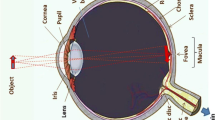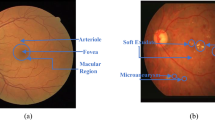Abstract
We present a fast, efficient, and automatic method for extracting vessels from retinal images. The proposed method is based on the second local entropy and on the gray-level co-occurrence matrix (GLCM). The algorithm is designed to have flexibility in the definition of the blood vessel contours. Using information from the GLCM, a statistic feature is calculated to act as a threshold value. The performance of the proposed approach was evaluated in terms of its sensitivity, specificity, and accuracy. The results obtained for these metrics were 0.9648, 0.9480, and 0.9759, respectively. These results show the high performance and accuracy that the proposed method offers. Another aspect evaluated in this method is the elapsed time to carry out the segmentation. The average time required by the proposed method is 3 s for images of size 565 × 584 pixels. To assess the ability and speed of the proposed method, the experimental results are compared with those obtained using other existing methods.
Graphical abstract





Similar content being viewed by others
References
Chanwimaluang T, Fan G (2003) An efficient blood vessel detection algorithm for retinal images using local entropy thresholding, vol 5. In: Proceedings of the International Symposium on Circuits and Systems, 2003. ISCAS ‘03. V-21–V-24
Chaohong W (2007) Advanced feature extraction algorithms for automatic fingerprint recognition systems. PhD dissertation, Faculty of the Graduate School of State University, Buffalo, New York
Chaudhuri S, Chatterjee S, Katz N, Nelson N, Goldbaum M (1989) Detection of blood vessels in retinal images using two-dimensional matched filters. IEEE Trans Med Imaging 8(3):263–269
Gonzalez R, Woods J (2008) Digital image processing, 3rd edn. Prentice Hall, New Jersey
Haralick RM, Shanmugam K, Dinstein I (1973) Textural features for image segmentation. IEEE Trans Syst Man Cybern, SMC-3, (6):610–621
HongQing Z (2004) Segmentation of blood vessels in retinal images using 2D entropies of gray level-gradient co-occurrence matrix, vol 3, issue 17–21. In: IEEE international conference acoustics, speech, and signal processing (ICASSP), pp 509–512
Hu J, Kahsi R, Lopresti D, Nagy G, Wilfong G (2001) Why table ground-truthing is hard. In: Proceedings of the sixth international conference on document analysis and recognition, ICDAR-01, pp 129-133
Jiang X, Mojon D (2003) Adaptive local thresholding by verification-based multi-threshold probing with application to vessel detection in retinal images. IEEE Trans Pattern Recogn Anal Mach Intell 25:131–137
Jung E, Hong K (2006) Automatic retinal vasculature structure tracing and vascular landmark extraction from human eye image. In: Proceedings of the international conference on hybrid information technology, ICHIT, IEEE Computer Society, pp 161–167
Kirbas C, Quek F (2004) A review of vessel extraction techniques and algorithms, ACM Computing Surveys, 36(2):81–121
Kriston-Vizi J, Chinta R, Puah WC, Tiehua D, Wasser M (2006) An ImageJ plugin for the benchmarking of 3D segmentation algorithms and the specification of ground truth dataset. Imaging Informatics Division, Bioinformatics Institute Agency for Science, Technology and Research (A*STAR), Singapore
Martinez-Perez M, Hughes A, Stanton A, Thom S, Bharath A, Parker K (1999) Scale-space analysis for the characterization of retinal blood vessels. In: Taylor C, Colchester A (eds) Medical image computing and computer-assisted intervention-MICCAI’99, pp 90–97
Niemeijer M, Staal JJ, van Ginneken B, Loog M, Abramoff MD (2004) Comparative study of retinal vessel segmentation methods on a new publicly available database. In: Michael Fitzpatrick J, Sonka M (eds) Proceedings of SPIE on SPIE medical imaging, vol 5370, 648, pp 648–656
Niessen W, Bouma C, Vincken K, Viergever M (2000) Error metrics for quantitative evaluation of medical image segmentation. In: Klette R, Stiehl H, Viergever M, Vincken K (eds) Performance characterization in computer vision. Kluwer, The Netherlands, pp 275–284
Pal NR, Pal SK (1989) Entropic thresholding. Signal Process 16:97–10
Siddalingaswamy PC, Prabhu GK (2007) Automated detection of anatomical structures in retinal images. In: International conference on computational intelligence and multimedia applications, vol 3, pp 164–168
Soares JVB, Leandro JJG, Cesar RM, Jelinek HF, Cree MJ (2006) Retinal vessel segmentation using the 2-D Gabor wavelet and supervised classification. IEEE Trans Med Imaging 25:1214–1222
Srivastavas V (2005) Performance of micro-calcification detection algorithms, Master thesis, Department of Electrical and Computer Engineering, North Carolina State University, Raleigh, NC, USA
Staal J, Abramoff M, Niemeijer M, Viergever M, van Ginneken B (2004) Ridge-based Vessel segmentation in color images of the retina. IEEE Trans Med Imaging 23:501–509
Wang L, Bhalerao A (2003) Model based segmentation for retinal fundus images. In: Proceedings of Scandinavian conference on image analysis (SCIA)
Yang CW, Dye M, Shuenn C, Chuin W, Chia W, Chien L, Pau C, Chein C (2000) Computer-aided diagnostic detection system of venous beading in retinal images. Society of photo-optical instrumentation engineers. Opt Eng, 39(1293):1293–1303
Zana F, Klein JC (1977) Robust segmentation of vessels from retinal angiography. In: International conference on digital signal processing. Santorini, Greece, pp 1087–1091
Zhang YF, Zhang Y (2006) Another method of building 2D entropy to realize automatic segmentation. International Symposium on Instrumentation Science and Technology. J Phys: Conf Ser 48:303–307
Acknowledgments
The authors of this paper wish to thank the National Polytechnic Institute, Center for Computing Research and Postgraduate and Research Secretary, Mexico, for their support under the research grant number SIP 20082213.
Author information
Authors and Affiliations
Corresponding author
Rights and permissions
About this article
Cite this article
Villalobos-Castaldi, F.M., Felipe-Riverón, E.M. & Sánchez-Fernández, L.P. A fast, efficient and automated method to extract vessels from fundus images. J Vis 13, 263–270 (2010). https://doi.org/10.1007/s12650-010-0037-y
Received:
Accepted:
Published:
Issue Date:
DOI: https://doi.org/10.1007/s12650-010-0037-y




